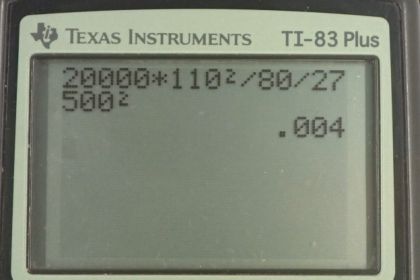Question
Compare the kinetic energy of a 20,000-kg truck moving at 110 km/h with that of an 80.0-kg astronaut in orbit moving at 27,500 km/h.
Final Answer
The kinetic energy of the truck is 0.4% of that of the astronaut.
Solution video
OpenStax College Physics for AP® Courses, Chapter 7, Problem 9 (Problems & Exercises)

vote with a rating of
votes with an average rating of
.
Calculator Screenshots
Video Transcript
This is College Physics Answers with Shaun Dychko. We're asked in this question to compare the kinetic energy of a truck of mass 20 thousand kilograms moving at 110 kilometers per hour to the kinetic energy of an astronaut of only 80 kilograms but moving at 27,500 kilometers per hour. Now, we'll compare them by taking the ratio of the two kinetic energies and so we have one half mass of the truck multiplied by speed of the truck squared, divided by one half mass of the astronaut times speed of the astronaut squared. The one halves cancel and we're left with this and we can substitute in numbers. Now since we're asked to find a ratio, we're allowed to take some shortcuts with our units. Normally given a speed like this in our kinetic energy formula we would have to convert this into meters per second. But since we're finding a ratio, whatever units this works out to, kilograms, kilometers squared over hours squared, those units are going to be the same on the bottom. Since the units are the same on the top and bottom they're going to cancel and so it doesn't matter what the units are, it just matters that the units are the same on the top and bottom when you're calculating a ratio. So we'll leave it like this and take that shortcut although you could turn this into meters per second and that would be fine too, it'd be just a little bit more work that's all. We get 0.004 is the ratio of the two kinetic energies and so that means the kinetic energy of the truck is 0.4 percent of the kinetic energy of t he astronaut. So that means that despite the astronaut being so much less massive than the truck, the higher speed of the astronaut more than compensates for that lower mass and that's partly because the speed is so massive but also partly because kinetic energy generally works like that in that the speed matters more than the mass because the speed is squared.
